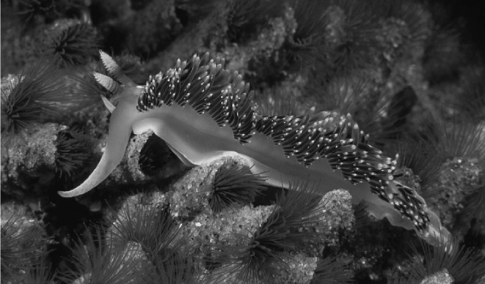Multiple Choice
Use the information to answer the following question.
The nontaxonomic term sea slug encompasses a wide variety of marine gastropods. One feature they share as adults is the lack of a shell. One might think, therefore, that they represent defenseless morsels for predators. In fact, sea slugs have multiple defenses. Some sea slugs prey on sponges and concentrate sponge toxins in their tissues. Others feed on cnidarians, digesting everything except the nematocysts, which they then transfer to their own skins. Whereas the most brightly colored sea slugs are often highly toxic, others are nontoxic and mimic the coloration of the toxic species. Their colors are mostly derived from pigments in their prey. There are also sea slugs that use their coloration to blend into their environments.
This nudibranch, a type of sea slug, has many reddish cerata on its dorsal surface, as well as two white-tipped rhinophores located on the head.
The nematocysts most likely reach the skin of sea slugs through branches of the ________.
A) intestine
B) excurrent siphon
C) nephridium
D) pseudocoelom
Correct Answer:

Verified
Correct Answer:
Verified
Q1: Molecular studies have changed many of the
Q3: The sharp, inch-long thorns of the crown-of-thorns
Q4: In terms of food capture, which sponge
Q10: Toilets are a modern convenience that people
Q27: Use the following information and figures to
Q40: Whiteflies are common pest insects found on
Q43: Which characteristic is shared by cnidarians and
Q46: What would be the most effective method
Q67: Which of the following combinations correctly matches
Q81: A terrestrial animal species is discovered with